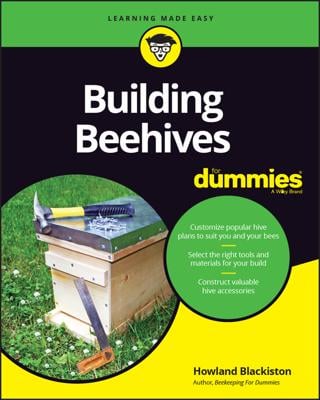After a routine bee hive inspection, a beekeeper must close his hive. Nine frames should be in the hive and one leaning against it or hanging on the frame rest (the first frame you removed). Putting the first frame back in the hive means:
Slowly pushing the nine frames that are in the hive as a single unit toward the opposite wall of the hive.
That puts them back where they were when you started your inspection. Pushing them as a single unit keeps them snugly together and avoids crushing bees. Focus your eyes on the “point of contact” as you push the frames together. You’re now left with the open slot from which the first frame was removed.
Smoking the bees one last time to drive them down into the hive.
Picking up the frame that’s outside the hive.
Are bees still on it? If so, with a downward thrust, sharply knock one corner of the frame on the bottom board at the hive’s entrance. The bees fall off the frame and begin walking into the entrance to the hive. With no bees remaining on your first frame, you can easily return it to the hive without the risk of crushing them.
Easing the wall frame into the empty slot.
Slowly, please! Make certain that all ten frames fit snugly together. Using your hive tool as a wedge, adjust the ten-frame unit so that the space between the frames and the two outer walls is equal.
You’re almost finished. Follow these steps to close the hive:
If you’re using a hive-top feeder, put it back in place immediately on top of the hive body.
Add more sugar syrup if the pantry is getting low.
If you’re not using a hive-top feeder, replacing the inner cover comes next.
First remove any bees from the inner cover. Use a downward thrust and sharply knock one corner of the inner cover on the bottom board at the hive’s entrance. Better yet, if there is a rock on the ground, use it as your hard surface rather than the bottom board (it’s less disturbing to the bees in the hive).
Place the inner cover back on the hive by sliding it in position from the rear of the hive so that you don’t crush any bees.
Very slowly slide it into place, and any bees along the top bars or on the edges of the hive will be pushed gently out of the way. Kind of like a bulldozer!
Note that the notched ventilation hole is positioned upward and toward the front of the hive. This notched opening allows air to circulate and gives bees a top floor entrance to the hive.
Replace the outer cover (the final step).
Make sure the outer cover is free of any bees. Tap it sharply on the ground to free it of bees. From the rear of the hive, slide it along the inner cover, again, gently pushing any bees out of the way (the bulldozer technique). Ease it into place, and adjust it so that it sits firmly and level on the inner cover.
Make sure that the ventilation notch on the outer cover isn’t blocked. From the rear of the hive, shove the outer cover toward the front of the hive. Doing so opens the notched ventilation hole in the inner cover and gives the bees airflow and an alternate entrance.

